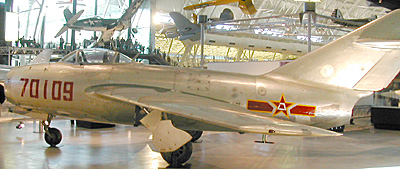 The MiG-15's existence was unsuspected in the West until American fighter pilots found themselves confronted by all-swept silver fighters that could fly faster, climb and dive faster, and turn more tightly.
The MiG-15's existence was unsuspected in the West until American fighter pilots found themselves confronted by all-swept silver fighters that could fly faster, climb and dive faster, and turn more tightly.
Mig-15bis "Fagot" parked in the modern section. Above the cockpit in the background is the F4U Corsair, and behind that is the entrance to the museum.
The development of the aircraft could be traced back to the decision of the post-war British government to send to the Soviet Union the latest British turbojet, the Rolls-Royce Nene, long before it was in service with any British service aircraft. This removed Mikoyan's problem of finding a suitable engine and by the end of December 1947 the prototype was flying, powered by an unlicensed version of the Nene. Losses in Korea were high, mainly because of pilot inexperience, but as late as 1960 the MiG-15 was still used as a fighter by 15 countries.
Country of origin: USSR
Type: single-seat fighter
Powerplant: one 2700kg (5952lb) Klimov VK-1 turbojet
Performance: maximum speed 1100km/h (684 mph); service ceiling 15,545m (51,000ft); range at height with slipper tanks 1424km (885 miles)
Weights: empty 4000kg (8820lb); maximum loaded 5700kg (12,566lb)
Dimensions: wingspan 10.08m (33ft 0.75in); length 11.05m (36ft 3.75in); height 3.4m (11ft 1.75in); wing area 20.60msq m (221.74sq ft)
Armament: one 37mm N-37 cannon and two 23mm NS-23 cannon, plus up to 500kg (1 102lb) of mixed stores on underwing pylons
Specs and description from: Attack and Interceptor Jets by Michael Sharpe (Fiedman/Fairfax, 1999, ISBN: 1-58663-301-S), a handy book covering 300 aircraft.
WWI
WWII
Japan: Kawanichi N1K2-Ja Shinden Kai (George)
US: Curtiss P40 Tomahawk
Post WWII
US: Northrop N-1M Flying Wing
Other
UHC Displays
Germany: Focke-Wulf FW-190F
Germany: Arado AR-234B
Germany: Junkers JU-52/3m
Germany: Focke-Achgelis FA-330A
Germany: Rheintochter R1 Anti-aircraft Missile (Rhine Maiden)
Japan: Kawasaki Ki-45 Kai Toryu (Nick)
Japan: Aichi M6A1 Seiran
Japan: Kugisho Ohka Model 22 Cherry Blossom
US: Vought F4U Corsair
US: Lockheed P-38J Lightning
US: Boeing B-29 Superfortress "Enola Gay"
US: Grumman F6F Hellcat
US: Republic P-47D Thunderbolt
UK: DeHavilland DHC-1A Chipmunk
US: Lockheed SR-71 Blackbird
US: Space Shuttle "Enterprise"
US: Lockheed Martin X35b Joint Strike Fighter
Back to List of Historic Sites
Back to Travel Master List
Back to MagWeb Master List of Magazines
© Copyright 2004 by Coalition Web, Inc.
This article appears in MagWeb.com (Magazine Web) on the Internet World Wide Web.
Other articles covering military history and related topics are available at http://www.magweb.com